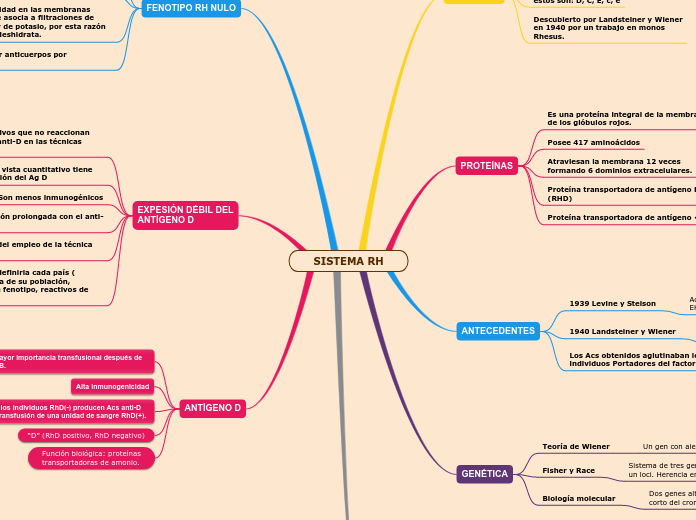SISTEMA RH
Type in the name of the book you have read.
BIOLOGÍA MOLECULAR
Mientras las Rh negativas tienen
únicamente el gen RHCE.
Las personas Rh positivas poseen genes
RHD.
La herencia de los antígenos Rh es
determinada por un complejo de dos genes
ANTÍGENO D
Type the main events of the book, classifying them in: events from the beginning, events from the middle, and events from the end of the book.
Describe the story visually. Add a representative picture for each of them.
Función biológica: proteínas
transportadoras de amonio.
“D” (RhD positivo, RhD negativo)
80% de los individuos RhD(-) producen Acs anti-D con la transfusión de una unidad de sangre RhD(+).
Alta inmunogenicidad
El de mayor importancia transfusional después de los A y B.
EXPESIÓN DÉBIL DEL
ANTÍGENO D
In contrast to the main idea, the theme is the message, lesson or moral of the book.
Some tips to find out the theme of the book easier:
- Try to find it while you are reading. It may be stated or implied.
- Think about how the characters reacted to obstacles.
- Think about the important decisions that the characters made.
- Think about the characters growing or changing throughout the book.
La políticas debe definirla cada país ( composición étnica de su población,
frecuencia de este fenotipo, reactivos de que dispone ).
Requiere empleo del empleo de la técnica de antiglobulina.
Requiere Incubación prolongada con el anti-D.
Son menos inmunogénicos
Desde el punto de vista cuantitativo tiene una menor expresión del Ag D
Eritrocitos D positivos que no reaccionan con los reactivos anti-D en las técnicas convencionales.
FENOTIPO RH NULO
Take notes while you read the book. Type here the resources, books, or websites that the author mentioned and you want to check out later.
Pueden producir anticuerpos por inmunización
Presentan debilidad en las membranas celulares que se asocia a filtraciones de iones de sodio y de potasio, por esta razón el eritrocito se deshidrata.
Ausencia de todos los Ags del sistema Rh,
incluyendo el relevante antígeno D
Es el grupo sanguíneo menos frecuente
que conocemos.
GENÉTICA
Biología molecular
Dos genes altamente homólogos en el brazo
corto del cromosoma 1.
Fisher y Race
Sistema de tres genes estrechamente ligados en un loci. Herencia en bloque o haplotipo.
Teoría de Wiener
The main idea is what the book is mostly about.
Some tips to find out the main idea of a book easier:
- Read the title.
- Look for the text features.
- Figure out if you are reading a fiction or a non fiction book.
- Think about some examples that support this idea.
Un gen con alelos múltiples
ANTECEDENTES
Type the names of the book characters. Start with the main character.
Draw arrows to represent the relationship between them and if it is possible write on them what they represent for each other (if they are relatives, friends, lovers, enemies etc.)
Los Acs obtenidos aglutinaban los eritrocitos del 85% de los individuos Portadores del factor Rh o Rh positivos
1940 Landsteiner y Wiener
Inmunización a conejos con hematíes del mono Macacus rhesus .
1939 Levine y Stelson
Acs en una puérpera con un hijo afectado por EHRN (Enfermedad hemolítica del recién nacido)
What are the characteristics that best describe the character? Type them here.
PROTEÍNAS
What is the reason why the author wrote the book?
Proteína transportadora de antígeno «C»
Proteína transportadora de antígeno D
(RHD)
Atraviesan la membrana 12 veces
formando 6 dominios extracelulares.
Posee 417 aminoácidos
Es una proteína integral de la membrana
de los glóbulos rojos.
CONCEPTO
Who is the author of the book? Type in his/her name.
Descubierto por Landsteiner y Wiener
en 1940 por un trabajo en monos
Rhesus.
Cinco son frecuentes,
estos son: D, C, E, c, e
Presenta más de 45 antígenos
Es el sistema más polimórfico

